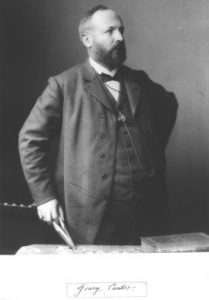On 6 January 2018 was the 100th anniversary of the death of Georg Cantor. His studies on infinity managed to tame this monster that had been terrorizing logic, mathematics and philosophy since its discovery by the Greeks in the 6th century BC. Cantor is considered the father of set theory (along with R. Dedekind, see Darwin and Wallace, Dedekind and Cantor), and started a revolution that ended up changing the way of making mathematics, initiating a process of abstraction characterized by the appearance of nonconstructive proofs of existence, and that boosted the one that algebra already experienced in the second half of the 19th century. After Cantor, we mathematicians have finally admitted that the existence of a certain mathematical object can be guaranteed even if it is not specified how this object can be constructed. Significantly, this process of abstraction in mathematics is contemporary with what has happened in sculpture, music or painting; especially with the latter two, where there are revealing similarities in the conception of the discourse of music, on the one hand, and of space, on the other, which are no less substantial, although not unexpected. Cantor coined an aphorism full of beauty that synthesises the characteristic that distinguishes mathematics from other sciences: “The essence of mathematics is freedom”.
Georg Cantor was a figure full of excess, a disproportionate personality, who was torn apart by the claws of madness, especially from 1899 onwards, when he was admitted to convalescent homes every two or three years, suffering from persecution and manic-depression.
It can’ t be denied that a certain melodramatic temptation can incline us to establish a relationship between Cantor’s studies on infinity and his mental illness. And not a few authors have allowed themselves to be dragged into it until it became a milestone in mathematical folklore that Cantor’s mental illness was caused by his obsession with unraveling the mysteries of infinity. Perhaps it was Bertrand Russell who collaborated most with this cause – perhaps inadvertently. Cantor visited Britain for the first time in September 1911; he was passing through London and wrote Russell a couple of letters proposing a meeting with him, which in the end did not take place. The fact is that Russell included in his autobiography, published in 1967-69, a reference to those two letters and to Cantor’s somewhat eccentric behaviour. “Georg Cantor was, in my opinion,” Russell wrote, “one of the finest brains of the nineteenth century […] After reading the following letter, no one will be surprised to learn that he spent much of his life in a asylum for mental patients”. Commenting on this, British mathematical historian Ivor Grattan-Guinness, one of the first to raise his voice against the mathematical reasons for Cantor’s madness, wrote in 1971: “Cantor’s two letters are undeniably erratic in character: indeed, the manuscripts are even more revealing. They show several of the habits he had when agitation was rampant. The calligraphy is very flowery and the lines tend to move upwards as they progress on the page; and not only do they continue in the margins – something typical of Cantor – but on one page of the second letter he even wrote from top to bottom on other lines which went, as usual, from left to right. There is even a paragraph from the letter that is written on the back of the envelope”.
It is quite possible that Cantor’s mental illness had genetic causes. “The lack of documentary evidence combined with the rudimentary nature of psychological treatments at the time prevents a definitive professional evaluation of Cantor’s mental illness,” wrote Grattan-Guinness. “The crises began suddenly, usually in autumn, and showed phases of excitement and exaltation. They also ended suddenly at the beginning of spring or summer, sometimes followed by what we now understand to be the depressive phase. This was then interpreted as a cure, during which Cantor spent time at home sitting in silence for hours on end; but then this phase also ended suddenly and Cantor returned to his work and occupations”.
Although genetic causes do not mean that the strain of their academic relationships or the tension of their struggle with infinity will not exacerbate or precipitate their mental crises. Since 1878 Cantor had been struggling to prove the continuum hypothesis (which establishes that the cardinal of the points of a line is the first non-numerable infinity). Naturally, he did not devote himself exclusively to the research of this problem, but it is beyond doubt that he devoted full years of effort to it that were as intense and passionate as they were sterile, and it is no less true that any news about the resolution of the problem always made a deep impression on him. But if the hypothesis of the continuum was disturbing to Cantor’s emotional stability, no less so were other tragedies of life such as that suffered in 1899 when Rudolf, the youngest of his six children, died at the age of 13.


In May 1917, Cantor was again interned against his will in the asylum at the University of Halle. According to Grattan-Guinness, “The war caused a shortage of food, and Cantor became thinner and prey to hunger as well as to fatigue and illness […] At New Year’s Eve, Cantor sent his wife the last forty pages of the previous year’s calendar, telling her that he had lived through those days; but on 6 January he died suddenly and painlessly of a heart attack. He was buried in Halle near his son Rudolf”.
References
A.J. Durán, Pasiones, piojos, dioses… y matemáticas, Destino, Barcelona, 2007.
I. Grattan-Guinness, Towards a biography of Georg Cantor, Annals of Science, 27, (1971), 345-391.

Que personaje tan complejo, otro matemático esquizofrènico, seguro debio ser imitado por Nash, finalmente tuvo el reconocimiento de la comunidad matemática